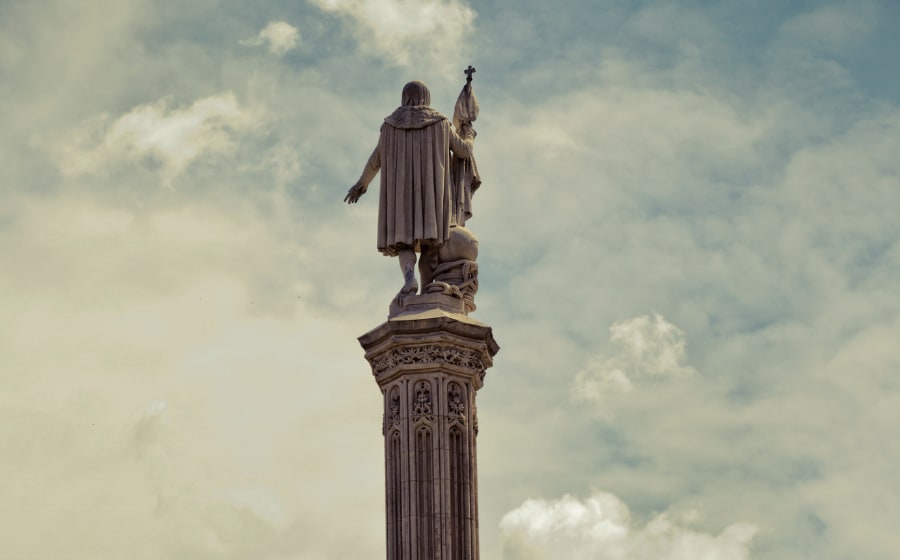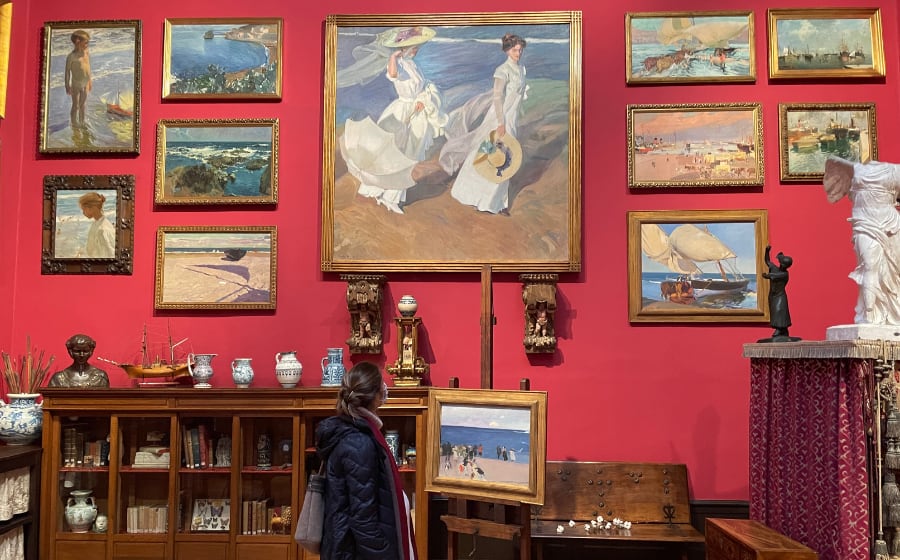9 Remarkable Paintings in Spain Considered Real Master Pieces
November 28, 2022
Win a FREE Trip to Spain!
Exciting Announcement! For the first time, we're thrilled to offer exclusive trips to the heart of Spain - an experience like no other. This isn't your typical tourist journey; it's a unique opportunity to immerse yourself in authentic Spanish culture, alongside real locals and our passionate team.
But there's more! Simply by requesting information about this amazing trip, you'll be entered into a special draw to win a Fully Paid Trip to Spain for Two. And that's not all - everyone who inquires will receive an exclusive bonus gift, valued at $500, available only now.
Ready to Discover the Real Spain?Click Here ↑ to Request Information & Enter the Draw!
Have you ever wondered what crosses painters’ minds? If you are into art, you probably do know, but if you are not…continue reading.
This article is for everyone with an appreciation for painting and the stories behind those talented strokes of paint.
After reading, you will be able to identify the styles of the great Spanish masters through their remarkable paintings.
As little heads-up, I tried to get the best pictures for this article, so let’s appreciate those humans out there that take them and are attributed in each of them!

If you are interested to read more about art, check this articles next!
Famous Spanish Painters: The 9 Old and Modern Masters of Art
Discover the 13 Best Sculptures in Spain You Need to Check Out
Top 9 Spanish Writers That Speak from their Hearts - 5 Nobels
Table of Contents ▼ ▶
1. Guernica
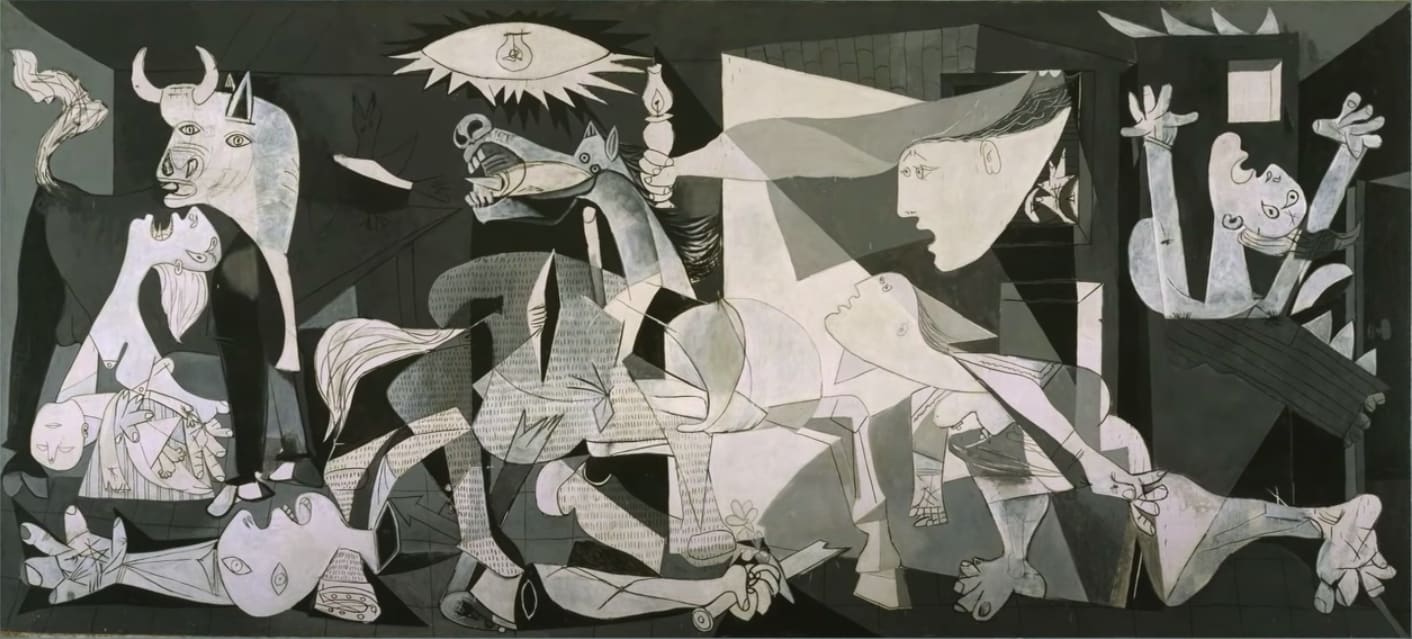
| Artist | Pablo Picasso |
|---|---|
| Medium | Oil on canvas |
| Dimensions | 776,6 cm × 349,3 cm |
| Year | 1937 |
| Museum | Museo Nacional Centro de Arte Reina Sofía |
| City | Madrid |
Guernica is an illustration of the consequences of war. It was 1937 when the Republic Government of Spain asked the cubist artist Pablo Picasso to paint a mural for the World Fair in Paris.
Picasso didn’t know what to paint, but in the daily newspaper, he read about a bombing. On April 26 that year, Hitler and Mussolini aided Franco to bombed the Basque city of Guernica. The bombing led to the Spanish dictator’s victory over the Republicans while killing thousands.
After reading about this event, Picasso decided to make it the subject of the mural, which he completed in 35 days. Photographers documented the creation and iteration process of the painting until it was shown to the world at the Parisian fair.
The painting is captivating. The absence of color creates a dramatic effect of a soulless world. The different elements spread all over the canvas cause disorder and loss of focus; the viewer can feel lost in front of it.
When asked about the symbols in the painting, Picasso expressed that it was up to the audience to interpret. Most elements, like the mother with her dead child (left corner), symbolize the pain, terror, and agony of the people in Guernica.
The eye-shaped light bulb is supposed to be the eye of God or humanity who present the atrocities of the so-called leaders. Continuing left to right, a woman holds a candle, which is supposed to represent hope. Finally, the woman burning in the bottom right corner has a similar position to Goya’s characters in his painting Third of May, meaning the victims of the Spanish dictatorship.
Picasso didn’t want his painting to touch Spanish soil until democracy was re-established. So, the Spanish image traveled around the world until Franco’s death. This masterpiece returned to Spain in 1981, and today you can admire it in the Museo Nacional Centro de Arte Reina Sofia.
2. Second of May 1808- The Charge of the Mamelukes
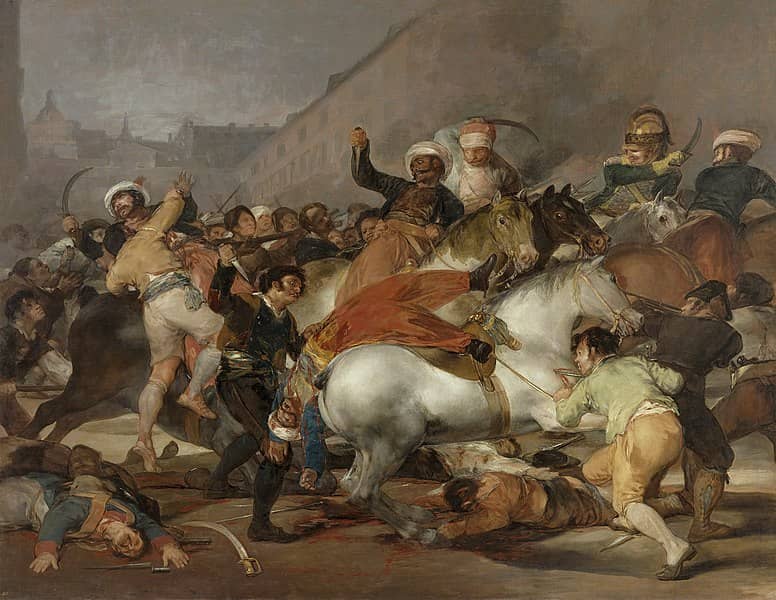
| Artist | Francisco Goya |
|---|---|
| Medium | Oil on canvas |
| Dimensions | 266 cm × 345 cm |
| Year | 1814 |
| Museum | Museo del Padro |
| City | Madrid |
It is not a coincidence that war is the theme of many painters until the twentieth century. Just like now, photography is used by many to capture the beauty and horror of our present world. Painters would do the same; they would use the canvas to show the events around them. Sometimes, artists would paint to process their thoughts and get images out of their heads. That way, they would be less haunted.
The painting, Second of May 1808, or the Charge of the Mamelukes, is one of the two-scene pieces by Francisco Goya. This Spanish painter began his career as the official portrait artist for the Roya court; his style underwent a visible evolution. From religious and royal family paintings to witchery, war, and death. The Second of May falls into the category of Goya’s darker period.
In the beginning, Goya favored French rule because they were supposed to symbolize enlightenment and liberation. However, the occupation turned violent and led Spain into a war of independence.
The Charge of the Mamelukes is set on Alcala Street near Puerta del Sol. It depicts the victims of the social and political upheaval of Spaniards fighting for their country. Let’s remember that Goya was a Romantic painter, and these artists sought the reflection of feelings, emotions, and moods. The picture should scream a sentiment to the viewer.
That is precisely what happens with his painting Second of May. Even though the scene is a fight with many casualties and another fighting, the two main characters of the centers have an aggressive and obscure expression. Both are filled with anger, and each action is for their cause.
This painting goes in hand with the following.
3. Three of May 1808- The Executions
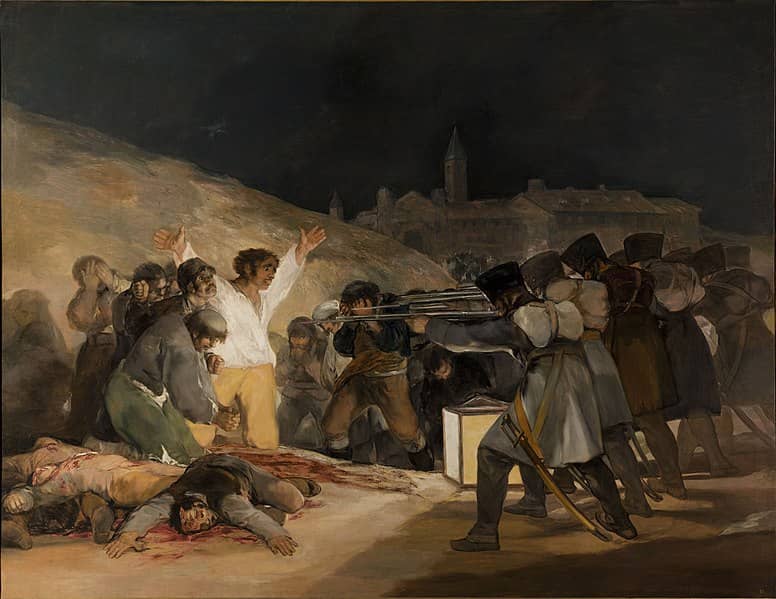
| Artist | Francisco Goya |
|---|---|
| Medium | Oil on canvas |
| Dimensions | 2.68 m x 3.47 m |
| Year | 1814 |
| Museum | Museo Nacional del Padro |
| City | Madrid |
This painting is the famous sister of Second of May and is also known as The Executions.
When Napoleon Bonaparte invaded Spain in 1808, he forced the abdications of Ferdinand VII and his father, Charles IV, and then installed his brother Joseph Bonaparte on the Spanish throne and promulgated the Bayonne Constitution. The occupation was violent, depicted in another of Goya’s masterpieces, “The Disasters of War,” for which I will leave you a note below.
On May 2, 1808, the Spaniards rebelled against the French and were gathered and executed on May 3. Once again, this is a Romantic piece that shows intense emotions between the two groups.
For once, the French soldiers seemed stiff, angry, and ready to murder, even if we couldn’t see their faces. The way Goya lined them up transmitted a certain feeling of fear. Fear is visible in the faces of the rebels, the victims. Their positions are chaotic. In most of them, you can feel the agony; others are praying and dead. The central character is framed by the light and shows the moment right before his death.
With these paintings, Goya reminded people that war is ugly, brutal, and has nothing heroic because anyone can be the victim or the oppressor.
“The Disasters of War” is a series of 82 individual prints that depict the horrors of the French invasion.
4. Las Meninas

| Artist | Diego Velázquez |
|---|---|
| Medium | Oil on canvas |
| Dimensions | 3.18 m x 2.76 m |
| Year | 1656 |
| Museum | Museo Nacional del Padro |
| City | Madrid |
“Las Meninas” is one of the most known and famous paintings of the Spanish Golden Age. Art experts say that the realism of the human form, straight lines, and movement characterized the Baroque style. And, Velázquez’s painting is one of its greatest examples.
“Las Meninas” is many things at once. It is a royal portrait, a self-portrait, and a history painting; Velázquez had fun with it and innovated the way of painting the royal family.
First of all, art historians say that the painting that the painter is painting is a painting (got it?) of King Phillip IV of Spain and his second wife, Mariana of Austria. Both are also reflected in the mirror on the wall at the end of the room.
Second, the entire portrait of the Infanta Margarita María de Austria and her aristocratic ladies or “Meninas,” María Agustina Sarmiento and Isabel de Velasco.
Then, there is Velázquez. Historians say it was a way of promoting himself and his intellect. He did what others didn’t dare to—created an informal and intimate picture of the royal family.
Something fundamental about this painting is the realism of each person done with undefined strokes. Velázquez even dissolves some elements, like his hands, giving dynamism to the painting.
5. Dream Caused by the Flight of a Bee around a Pomegranate a Second before Wakening up
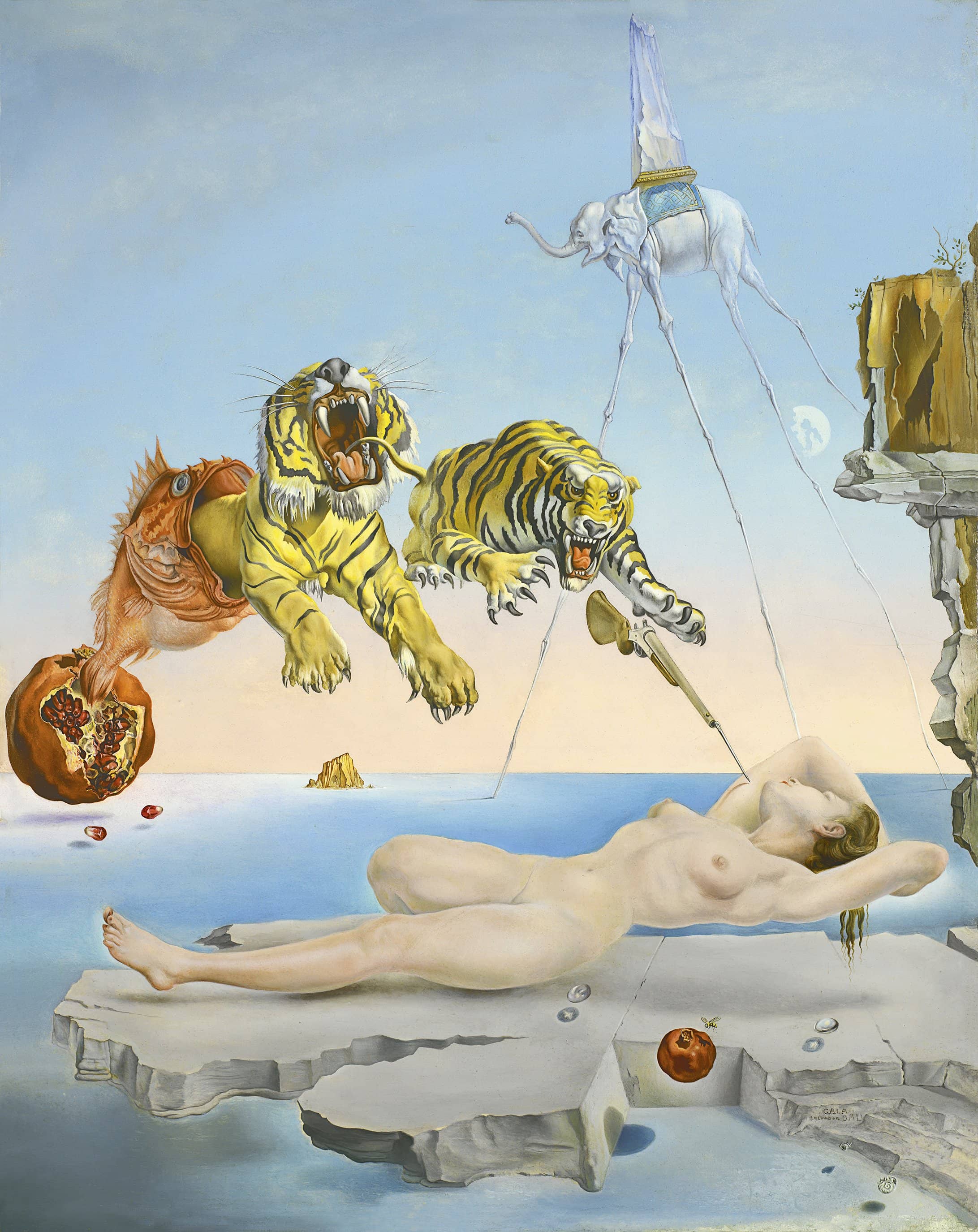
| Artist | Salvador Dalí |
|---|---|
| Medium | Oil on panel |
| Dimensions | 51 x 41 cm |
| Year | 1944 |
| Museum | Museo Nacional Thyssen-Bornemisza |
| City | Madrid |
This painting is a wild jump from Baroque to Surrealism, but it's okay; we are not following an order. Salvador Dalí was a surrealist painter who enjoyed exploring the sub-conscience, dreams, and mind processes. Surrealists sought to revolutionize the human experience.
This art movement was heavily influenced by Sigmund Freud’s theories on the subconscious and men’s sexuality. Both a very recurrent in Dalí’s paintings.
The main character of his painting is his wife and muse, Gala, the woman floating over the rock. If we could separate the painting into two different scenes, we could clearly picture Gala leaving her pomegranate next to her side in a beach landscape while falling asleep. And once she sleeps, her subconscious remembers the pomegranate, but a rockfish is coming out of it, and out of it, two big angry tigers, one after the other, and finally, a gun right over her. At the same time, in the back of the dream is a giant elephant with an obelisk on top.
There is no official meaning behind the symbols of this painting, but you can perceive the surrealism of it all by showing the dream unfold on top of the Gala.
6. Saturn Devouring His Son
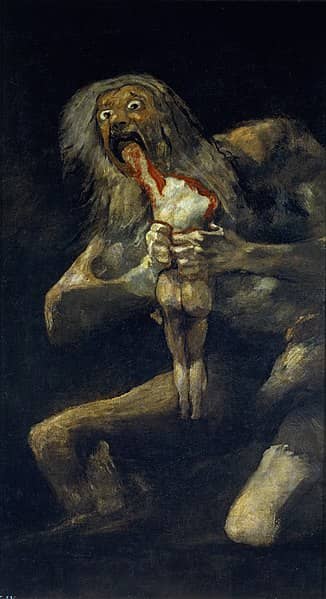
| Artist | Franciscon Goya |
|---|---|
| Medium | Mixed media transfered to canvas |
| Dimensions | 143.5 cm × 81.4 cm |
| Year | 1819 - 1823 |
| Museum | Museo Nacional del Padro |
| City | Madrid |
We have talked about Goya before, and we know he went through different stages in his artistic life ending with what historians call the “Black Paintings.” Pieces that combine his frustrations towards Spanish society, the wars, and his diseases.
Goya was around seventy years old when a disease struck him and left him completely deaf. The painter moved into a villa close to Madrid, “la Quinta del Sordo,” where he painted many walls with tenebrous scenes.
It is traditionally interpreted as a depiction of the Greek myth of the Titan Cronus (Saturn in Roman mythology) eating one of his offspring, who feared that one of them would overthrow him. There are many inspirations for what Goya wanted to express with this painting. Some say the Spanish society is eating itself, or Goya’s demons are consuming him. Another analysis that I find very interesting is about his children.
Saturn ate six of seven offspring. Goya had seven kids, and only one survived as an adult. The interpretation here is that he felt guilty, maybe even disgusted, that he lived a long life while his children died.
Even though the mature dead body of Saturn’s child is disturbing, the most alarming element is Saturn’s eyes. The titan has wide-open crazy eyes communicating panic, disgust, and pain.
7. Galatea of the Spheres
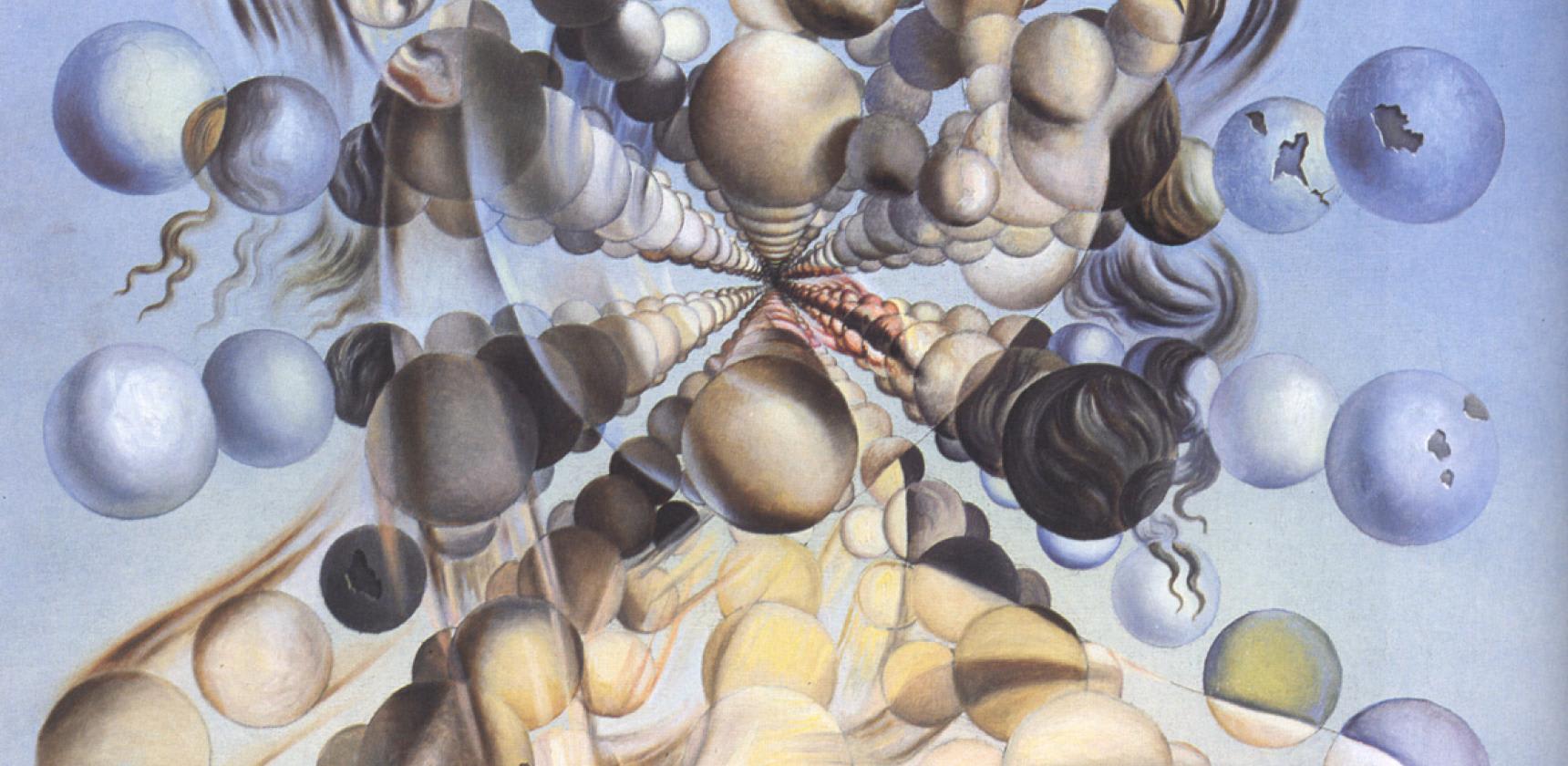
| Artist | Salvador Dalí |
|---|---|
| Medium | Oil on canvas |
| Dimensions | 65 cm × 54 cm |
| Year | 1952 |
| Museum | Dalí Theatre and Museum |
| City | Figueres |
I believe you will find this painting very interesting. Galatea of the Spheres again has Dalí’s wife, Gala, as the main character.
The painting is a bust that resembles a Renaissance style combined with atomic spheres. Srt experts argue that the Renaissance style expresses his renewed faith in Catholicism. At the same time, the spheres represent his interest in nuclear physics and his fascination for DNA structure.
8. The Burial of the Count of Orgaz

| Artist | El Greco |
|---|---|
| Medium | Oil on canvas |
| Dimensions | 4.8 m x 3.6 m |
| Year | 1586 |
| Museum | Santo Tomé Church |
| City | Toledo |
As you can see in the description table, The Burial of Count Orgaz was painted towards the end of the sixteenth century, but when "El Greco" was established in Toledo, he found the story of Don Gonzalo Ruiz, the lord of the town of Orgaz.
The Count of Orgz died in the fourteen century, but before he left Earth, he donated his money to the church of Saint Tomé. The legend says that Saint Agustin and Saint Stephen were so thankful for his deeds that they both came down to bury him.
This painting has two main sections: Earth and Heaven. Earth has darker colors, while heaven goes for light, pastel colors that transmit a calmer feeling.
The line of men in the bottom part of the painting represents men from the Order of Santiago but is also the symbolic division between heaven and Earth. Most of the characters at the bottom have darker, gloomy colors, while the Saints carry golden clothes that carry attention to the dead body.
In heaven, the figures are more elongated and lighter and receive the soul of Coun Orgaz.
This painting by “El Greco” is an excellent example of Renaissance and late mannerisms.
9. Women Walking on the Beach
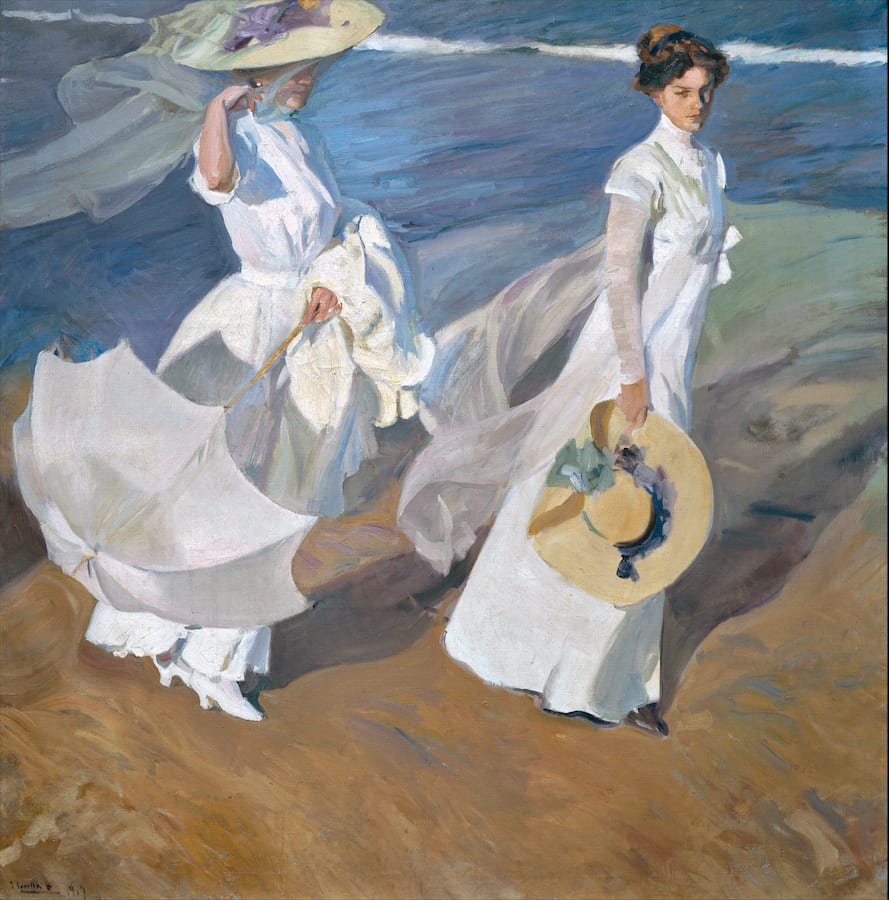
| Artist | Joanquín Sorolla |
|---|---|
| Medium | Oil on canvas |
| Dimensions | 205 cm × 200 cm |
| Year | 1909 |
| Museum | Sorolla Museum |
| City | Madrid |
Joaquín Sorolla was an Impressionist painter that met success during his life. He was known as the master of light, and Women Walking on the beach is an example of his talent.
This painting captures an ordinary day in Sorolla’s life as his muses are his wife and daughter strolling through a beach in Valencia.
Like every superb impressionist, Sorolla captures the change of light on a long day with the use of colors, shadows, and lights. The background of the sand merging with the sea in the second picture is a beautiful use of strokes, a reflection of colors on the wet sand.
Okay! Now you have a complete list of the most remarkable Spanish paintings that you can find in Spain. Our masters of old times have plenty more, but those paintings are spread around the world.
If you visit and (at least enjoy art) I would definitely recommend going to any of them. Just pick one! I promise you won’t regret it. The museums in Madrid are filled with so much culture and youth you’ll be surprised.




